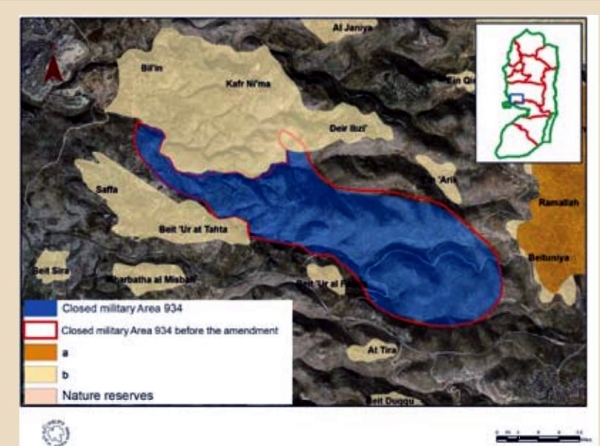The aim of this shift was to advance a process that would enable the submission of claims for Palestinians who want to access two archeological sites. One of the sites is situated at the Halamish settlement and the other at the Barkan settlement, near the village Hares.
Meetings were scheduled for discussing the main aim, and others at Nebi Salah, with N., and at Dir Nizam, with M.
The entrance to Nebi Salah from road 465 was blocked. N. came to visit us at the CP and joined us for the meeting with M. from Dir Nizam, for which I very much thank Zvia Shapira, who made the connection possible. At Nebi Salah the demonstrations have stopped during the last months, not least because the army used gas for the dispersion of demonstration. When this kind of gas hits the soil everything that grows on is seems dry and dwarfed.
There is an open-minded search for different means of expressing the opposition to the occupation. One of the ideas, for instance, is the oragnisation of the vast documentary material which has accumulated at the “Gandi” demonstrations, which were held at Nebi Salah and at Bil’in, Ne’ilin, and Budrus – and using it as a means of propaganda. The second idea isto acquire knowledge of the region, which is abundant with springs and archeological sites, and setting out with the village children (three hundred children) for guided tours of the neighourhood.
The three-story Maqam building, which stands vacant12 years after its refurbishment, could serve as a center for such activities.
We discuss all this with N. The owner of the land on which the antiquities site “Huwlata" at Halamish is situated, is prepared to join the process of demanding accessibility.

Road 465 connects Nebi Salah to Dir Nizam. Each village has two entrances from this road: one is permanently closed and the other only sometimes. Near the open entrance to Dir Nizam stands a military jeep. As we have not yet managed to reach M. We begin touring together with N. The enormous burial caves are from the Roman period. M. arrives with the Head of the Majelas and his two assistants, and N. explains to them the purpose of our visit. Archeology, but not only that. Hanna Zohar has come up with an idea as a result of complaints at the baladiyes about sewage problems, and also to save energy by recycling food waste using inexpensive means (composters) that suit the private home in the village. The Palestinians were very interested. (for the next meeting Hanna will bring more information).
At this point we received two invitations from the Head of the village and from M. - to come with them to the village café or to go up the hill of Tibni, or Hirbat Tibni, inside which an ancient town is buried, whose notables, kings or aristocrats, were buried in the caves which we had visited earlier. We chose the hill, and set out with N. and M. who turned out to be an expert who knows about each aspect of this amazing site. When we descended from the hill the head of the village surprised us with hot tea and we had a small feast with the chocolate we had brought with us.
I couldn’t but envisage the children of Nebi Salah and Dir Nizam joining such a tour.
From the hil, one see not only the archeological site and a breathtakingly beautiful landscape but also a white road that goes nowhere but serves as parking and as an observation point for the military jeep. This observation point overlooks the houses of Dir Nizam, the exits and entrances to road 465. The jeep went up and came down and once positioned itself at the entrance to Dir Nizam and once at the observation point from its private road.
